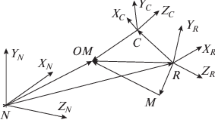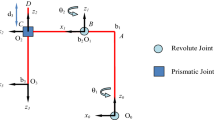Abstract
A mobile manipulator is a manipulator mounted on a mobile platform with no support from the ground. We are already in the process of building a platform (RISCbot II) which consists of a comprehensive sensor suite and significant end-effector capabilities for manipulation. In order to reduce the uncertainty in localization, sensor fusion is used to create an efficient and effective user interface to facilitate teleoperation by enhancing the quality of information that is provided to the teleoperator. We are developing a framework for a modular design of sensory modules, actuation platforms, and task descriptions that will be implemented as a tool to reduce and streamline efforts in designing robotic platforms. The framework is comprised of three modules. The first module encapsulates the sensors which gather information about the remote, or local, environment. The second module defines the platforms and actuation methods. The last module describes the tasks that the platforms will perform such as teleoperation, navigation, obstacle avoidance, manipulation, 3-D reconstruction, and map building. This paper presents the modular design process of the RISCbot II mobile manipulator. In the design process, the overall design of the system is discussed and then the control process of the robot is presented. Furthermore, the tasks that the RISCbot II can perform such as teleoperation, navigation, obstacle avoidance, manipulation, and face detection and recognition are described.
Similar content being viewed by others
Explore related subjects
Discover the latest articles, news and stories from top researchers in related subjects.References
Konolige, K., Myers, K., Ruspini, E., Saffiotti, A.: The saphira architecture: a design for autonomy. J. Exp. Theor. Artif. Intell. 9, 215–235 (1997)
Indratmo, A.H.: A tool for mobile robotics research. J. Tek. Elektro 2(1), 3 (2002). Available online at http://puslit.petra.ac.id/journals/articles.php?PublishedID=ELK02020103
Lindstrom, M., Oreback, A., Christensen, H.: Berra: a research architecture for service robots. In: Robotics and Automation, 2000. Proceedings. ICRA ’00. IEEE International Conference on, vol. 4, pp. 3278–3283 (2000)
Volpe, R., Nesnas, I., Estlin, T., Mutz, D., Petras, R., Das, H.: The claraty architecture for robotic autonomy. In: Aerospace Conference, 2001, IEEE Proceedings, vol. 1, pp. 1/121–1/132 (2001)
Nesnas, I.A., Simmons, R., Gaines, D., Kunz, C., Estlin, A.D.-C.T., Madison, R., Guineau, J., McHenry, M., Shu, I.-H., Apfelbaum, D.: Claraty: challenges and steps toward reusable robotic software. Int. J. Adv. Robot. Syst. 3(1), 023–030 (2006)
Nesnas, I.A.D., Wright, A., Bajracharya, M., Simmons, R., Estlin, T.: Claraty and challenges of developing interoperable robotic software. In: Invited to International Conference on Intelligent Robots and Systems (IROS), pp. 2428–2435 (2003)
Bergbreiter, S., Pister, K.: Cotsbots: an off-the-shelf platform for distributed robotics. In: Intelligent Robots and Systems, 2003. (IROS 2003). Proceedings. 2003 IEEE/RSJ International Conference on, vol. 2, pp. 27–31, 1632–1637 (2003)
Real Time Obstacle Avoidance for a Riscbot II with a Navigation Task. Online: http://www.youtube.com/watch?v=EmQxAS0TNn0 (2009)
Hassanien, A.-E., Abawajy, J.H. Abraham, A., Hagras, H. (eds.): Pervasive computing: innovations in intelligent multimedia and applications. Springer, New York (2009)
Siegwart, R., Nourbakhsh, I.R.: Introduction to Autonomous Mobile Robots, 1st edn. Ser. Intelligent Robotics and Autonomous Agents Series. The MIT Press (2004)
Viola, P., Jones, M.: Rapid object detection using a boosted cascade of simple features. In: Proc. IEEE Computer Society Conference on Computer Vision and Pattern Recognition CVPR 2001, vol. 1, pp. I-511–I-518 (2001)
Tjahyadi, R., Liu, W., An, S., Venkatesh, S.: Face recognition via the overlapping energy histogram. In: IJCAI (2007). Available online at http://www.ijcai.org/papers07/Papers/IJCAI07-465.pdf
Elkady, A.Y., Mohammed, M., Sobh, T.: A new algorithm for measuring and optimizing the manipulability index. J. Intell. Robot. Syst. 59(1), 75–86 (2009)
Khatib, O.: Real-time obstacle avoidance for manipulators and mobile robots. Int. J. Rob. Res. 5(1), 90–98 (1986). Available online at http://portal.acm.org/citation.cfm?id=6812
Lv–Maxsonar®–EZ0™ Data Sheet. Online: www.maxbotix.com (2007)
Author information
Authors and Affiliations
Corresponding author
Rights and permissions
About this article
Cite this article
Elkady, A.Y., Babariya, V., Joy, J. et al. Modular Design and Implementation for a Sensory-Driven Mobile Manipulation Framework. J Intell Robot Syst 62, 355–381 (2011). https://doi.org/10.1007/s10846-010-9454-3
Received:
Accepted:
Published:
Issue Date:
DOI: https://doi.org/10.1007/s10846-010-9454-3




